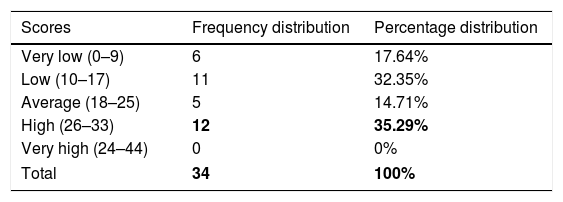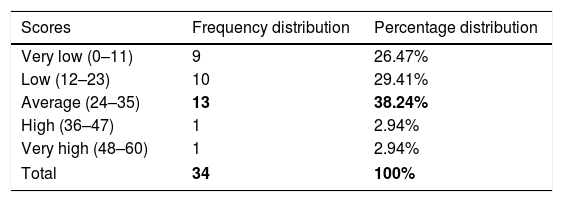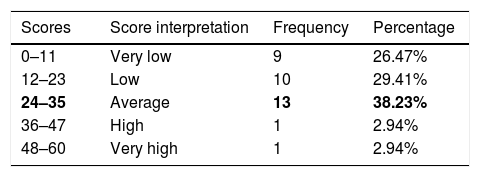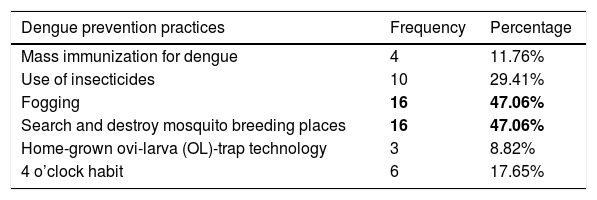This study aims to provide assessment tool on public elementary schools in Iligan City regarding corresponding level of knowledge of the educational workforce on Dengue Fever and Insecticide Treated Screen (ITS) program, perceptions and prevalent anti-dengue practices for which to support Anti-Dengue Advocacy Program.
MethodsThe study utilized a descriptive research design. It involves general knowledge as to the causes and mode of transmission of dengue fever. It also determined the level of knowledge of ITS as a program on the following parameters distribution, coordinating programs, composition, level of protection, durability, effectivity, and usage as well as their perception regarding the usefulness, amount of information dissemination, level, prevalent practices benefits and possible barriers on the utilization of Insecticide Treated Screen (ITS) program.
ResultsThis study yields respondents have higher understanding on the concept of dengue, low understanding on Insecticide Treated Screen as a program and average understanding of ITS as a product. Probable barriers have been identified that limits the use of the product, which include ITS being prone to damage by the students.
ConclusionThis study implicates respondents are fairly knowledgeable of ITS as a product, it does not coincide with their knowledge of ITS as a program. Information dissemination is limited particularly on the subject of ITS being a program.
The launch of the Insecticide Treated Screen program demonstrates the health organizations, educational, social organizations, DOH, DepEd and DSWD consideration regarding the product's effectivity. Multiple researches attest on the benefits the ITS offers toward vector control that does not necessarily limit itself on dengue prevention.1 Programs and preventive innovations were introduced to the Filipino public. In the year 1993, DOH initiated the National Dengue Prevention and Control Program was then extended to a nationwide operation in 1998. Different means of vector controls and preventive practices have been encouraged throughout the decades of exposure, from bed nets to larval control, to the 4 o’clock habit then finally the Insecticide Treated Screen: a program in association with Department of Education's “Brigada Kalinisan Para sa Kalusugan and Dengue Campaign” where 10,000 rolls of permethrin-treated screens were distributed to public elementary schools nationwide to fortify vector management. This innovation aims to protect students for three to five years not only from mosquito bites, but including cockroaches, flies and bees as well.2
Examining student perception in dengue control particularly in the larval vector management data presents that there were nearly twice as many attitude-related responses as knowledge-related responses. Health education and promotion is deemed of equal importance in the scope of knowledge and behavior improvement toward dengue control. Behavior toward practicing intervention reflects the individual's confidence concerning the particular intervention's effectivity and impact on the general public health.3 Permethrin is a synthetic chemical and is present in most insecticide. Effective against mosquitoes, cockroaches, flies, lice and other insects. It affects insects as they make contact or eat the substance, it targets the nervous system resulting to muscle spasms, paralysis and death. It is safe with dogs but not as quite as cats, are sensitive to this chemical. Humans if exposed to permethrin removes the substance through urine or feces.4 In Mexico, an area of consistently high dengue transmission, researchers investigated the effect on vector infestations of permanently mounted, insecticide-treated screens fitted to doors and windows of residential houses.5
Presently, almost 800 new dengue causes were reported across the Northern Mindanao. This brought the number of dengue patients nationwide to more than 170,000 as of August 17, 2019. Overall, the number of deaths attributed to the mosquito-borne disease has reached 720 nationwide, from just 622 deaths earlier this month, the health department said. About 70 of the new fatalities were recorded in northern Mindanao.6 Local dengue cases have so far reached 1138 with 14 deaths from January 1 to August 17 this year, according to the Iligan City Health Office.
Availability of ITS innovation against dengue vector management carries an implication of improvisation in preventive practices in which, knowledge of this technology is integral if we are to proceed with this development. Since public elementary schools have been established as the primary beneficiaries of the said program, awareness is examined among Iligan City's public-school officials and faculty in the aspects of general knowledge about Dengue,7 the ITS composition, and the ITS program. With this innovation coupled with the documented increasing incidence of Dengue cases in Iligan City, this paper aims to determine knowledge and perceptions of the public regarding Insecticide Treated Screen (ITS) program.
MethodResearch designThe study utilized a descriptive research design. It involves description on dengue fever general knowledge as to the causes and mode of transmission. Moreover, it also determined the level of knowledge of ITS as a program specifically on the following parameters – distribution, and coordinating programs, composition, level of protection, durability, effectivity, and usage as well as their perception regarding the usefulness, amount of information dissemination, level of knowledge, prevalent practices benefits and possible barriers on the utilization of Insecticide Treated Screen (ITS) program.
Population and study settingThis study was conducted in three public elementary schools in Iligan City, Northern Mindanao, Philippines. The researchers selected these particular elementary schools because of the high rates of dengue cases. Purposive sampling was employed in the selection of public elementary schools. Random sampling was applied in the selection of the 34 faculty and staff employed in the preferred public school.
Data collectionThe modified structured questionnaire was used as the main data-gathering instrument for this study. The questionnaire consists of the following: Section A: Demographic Characteristics; Section B: General Knowledge of Dengue particularly the cause and transmission; Section C: Level of Awareness of ITS as a program – distribution, and coordinating programs, primary beneficiary and year of enactment; Section D: Level of Knowledge of ITS – composition, level of protection, durability, effectivity and usage. Section E: Perception regarding the Insecticide Treated Screen's usefulness, information dissemination, their level of knowledge, benefits, and barriers to use. Section F: Prevalent Practices of Dengue Management. The researchers used a standardized questionnaire on this study concerning the knowledge of dengue and incorporated questions using the information regarding ITS provided by the DOH.8 The profile contains socio-demographic characteristics of the respondents such as age, gender, civil status, school, and years in service. The instrument used a 5-point Likert-type scale (e.g. 1=strongly disagree, 2=disagree, 0=neutral, 3=agree, 4=strongly agree) and reverse order intermittently. The items that used the order as represented above were nine and ten in part B and two, four, five, six, seven, ten and fifteen in part D. The items that used the reverse order were one, two, three, four, five, six, eight, nine, and eleven in part B, and one, three, nine, eleven, twelve, thirteen and fourteen in part D.
Research instruments and its validityA modified-structured questionnaire was utilized to obtain information on the variables being investigated in this study. The questions were obtained from DOH official website and used a standardized questionnaire on his study concerning the knowledge of dengue.8 To test the validity of the questionnaire, a pilot study was conducted. The researchers chose twenty (20) respondents in selected Barangays in Iligan City, using accidental sampling and these chosen respondents were included in the final conduction of the study. The questionnaire was validated by a panel of 3 experts: one (1) registered nurse with master's in medical–surgical nursing, one (1) registered nurse with master's in nursing service administration, and one (1) registered nurse with masters in community health nursing. More so, the pilot test was validated through Cronbach's alpha.
Data analysisData were analyzed using frequency and percentage to describe the demographic profile of the respondents. It was used to determine demographic characteristics of the respondents – age, gender, civil status, school of occupation, and years in service. This was also used to determine the level of knowledge of the respondents from their answers from Section B to D. Frequency distribution was used to determine the number of times an answer was chosen through all questions from Section B to E. This was also accompanied by percentages which helped express ratio and proportion (Tables 1–4).
Percentage distribution according to the level of knowledge and awareness of Dengue.
| Scores | Frequency distribution | Percentage distribution |
|---|---|---|
| Very low (0–9) | 6 | 17.64% |
| Low (10–17) | 11 | 32.35% |
| Average (18–25) | 5 | 14.71% |
| High (26–33) | 12 | 35.29% |
| Very high (24–44) | 0 | 0% |
| Total | 34 | 100% |
Majority of the respondents that is 12 (35.29%) (in bold) has a score of 26-33 which means they are highly knowledgeable regarding the causes and transmissions of Dengue.
Percentage distribution according to the level of knowledge and awareness of Insecticide Treated Screen: composition, protection, durability, effectivity, and usage.
| Scores | Frequency distribution | Percentage distribution |
|---|---|---|
| Very low (0–11) | 9 | 26.47% |
| Low (12–23) | 10 | 29.41% |
| Average (24–35) | 13 | 38.24% |
| High (36–47) | 1 | 2.94% |
| Very high (48–60) | 1 | 2.94% |
| Total | 34 | 100% |
Majority of the respondents that is 13 (38.24%) (in bold) indicates average level of knowledge regarding the composition, protection, durability, effectivity, and usage of the Insecticide Treated Screen.
Distribution of respondents scores to perception of own level of knowledge.
| Scores | Score interpretation | Frequency | Percentage |
|---|---|---|---|
| 0–11 | Very low | 9 | 26.47% |
| 12–23 | Low | 10 | 29.41% |
| 24–35 | Average | 13 | 38.23% |
| 36–47 | High | 1 | 2.94% |
| 48–60 | Very high | 1 | 2.94% |
Majority of the respondents (13, 38.23%) (in bold) scored within the range of 24-35 which is classified as having average level of knowledge in the concept of ITS as a product.
Distribution of respondent's answers to item 1 Part E: What are the prevalent dengue prevention practices in your school?
| Dengue prevention practices | Frequency | Percentage |
|---|---|---|
| Mass immunization for dengue | 4 | 11.76% |
| Use of insecticides | 10 | 29.41% |
| Fogging | 16 | 47.06% |
| Search and destroy mosquito breeding places | 16 | 47.06% |
| Home-grown ovi-larva (OL)-trap technology | 3 | 8.82% |
| 4 o’clock habit | 6 | 17.65% |
Majority of the respondents that is 16 (47.06%) (in bold) answered Fogging as well as Search and Destroy mosquito breeding places 10 (29.41%) answered use of Insecticides 6 (17.64%).
The researchers ensured that the ethical protocol was followed before and during the data gathering process. Data gathering and intervention started after the approval of the College Research and Ethics Committee (CREC). This study utilized participants who agreed to be part of the research project after voluntarily signing the informed consent form given during the orientation. The participants were assured that the data collected will be treated with full confidentiality and that it cannot be disclosed elsewhere, except for the intended study and will not be used against them.
ResultsResults finding that majority of the respondents that is 12 (35.29%) has a score within 26–33 which means they are highly knowledgeable regarding the causes and transmissions of Dengue. Majority of the respondents which got 15 (44.12%) indicates a low level of knowledge regarding the distribution, prevention, beneficiaries, and intervention of the Insecticide Treated Screen. Lastly, majority of the respondents which got 38.23% are within average level of knowledge of Insecticide Treated Screen (ITS) as a product. Gathering all scores from all 3 parts of the questionnaire, it is found that 50% of the respondents got a score within 21–42 range which indicates low level of knowledge.
On the concept of the Insecticide Screen, respondents answered that information dissemination is average. Regarding the usefulness of the product, respondents rate it as average. Subjects responded on the benefit of ITS's in reducing the number of dengue carrying mosquitoes. Probability of children damaging the screen is identified as one of the barriers. Majority practice Fogging and Search and Destroy Dengue Breeding places techniques toward Dengue Management. In relation, it is recommended that to perform widespread information drive about Dengue and the Insecticide Treated Screen to address the community concerns on the possible harmful effects of ITS.
Discussion and conclusionThe study found out that the respondents have a higher understanding on the concept of Dengue, low understanding on ITS as a program and average understanding of ITS as a product. This data implicates that although respondents are fairly knowledgeable of the ITS as a product, it does not coincide with their knowledge of ITS as a program. Taking this into account, it appears that limited information have been disseminated particularly on the subject of ITS being a program which is just as vital as it is included in their Anti-Dengue Advocacy Program. Information dissemination, Level of Knowledge, and Usefulness of the ITS were perceived as average. Respondents are also aware of the benefits that include with the use of the ITS, and that is being able to reduce number of dengue carrying mosquitoes in addition, respondents also identifies probable barriers that may limit the use of the product which include that being prone to damage by the students. Lastly, 2 of the most prevalent dengue prevention strategies being practiced are to search and destroy mosquito breeding places and fogging. Although dengue prevention practices are being implemented, it appears that the updates on appropriate anti-dengue strategies are limited. This study provided an assessment tool for which to implement interventions upon critical knowledge gaps.
Conflict of interestThe authors declare no conflict of interest.
Peer-review under responsibility of the scientific committee of the 3rd International Conference on Healthcare and Allied Sciences (2019). Full-text and the content of it is under responsibility of authors of the article.










